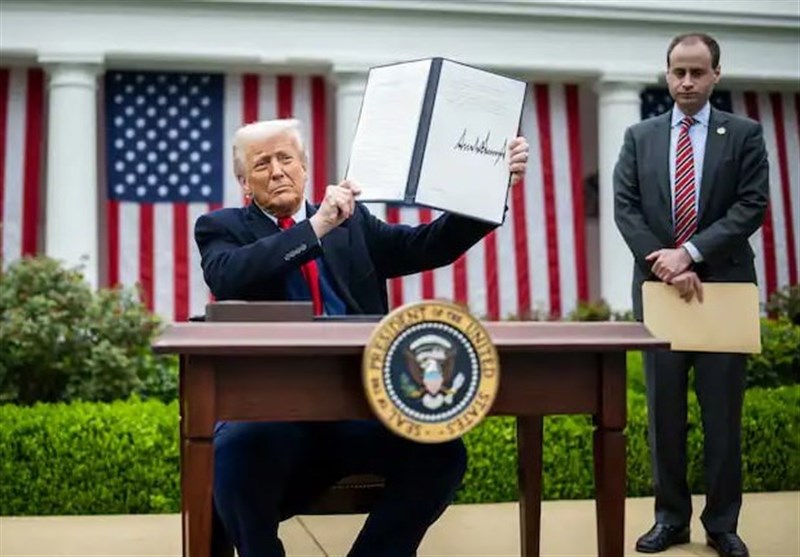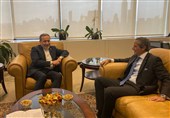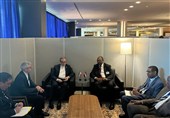Trump's 10% Global Tariff Takes Effect As Markets Plunge Amid Trade War Fears
TEHRAN (Tasnim) – US President Donald Trump’s sweeping 10% tariff on imports from nearly all countries took effect Saturday, shaking global financial markets and sparking warnings of escalating trade tensions.
The blanket tariff, announced by Trump during a speech on “Liberation Day” Wednesday evening, triggered widespread losses in stock markets worldwide.
The measure imposes a 10% baseline tariff on imports from most countries, with exceptions for Canada and Mexico.
Higher duties targeting specific trading partners — including a 20% tariff on EU goods and 34% on Chinese products — are scheduled to begin on April 9.
A separate 25% tariff on all foreign-made cars entering the US came into force on Thursday.
The White House said the tariffs were enacted under emergency economic powers to address longstanding trade deficits, which it blamed on “an absence of reciprocity” and “exorbitant value-added taxes” in other countries.
The moves provoked immediate financial fallout.
The FTSE 100 recorded its steepest daily drop since March 2020, closing 4.95% lower on Friday.
In the US, the Dow Jones Industrial Average, S&P 500, and Nasdaq Composite all fell more than 5%, marking their worst day since the onset of the COVID-19 pandemic.
Analysts estimate that approximately $4.9 trillion has been wiped off the value of global stock markets since Trump’s announcement.
As markets tumbled, Trump remained out of sight at his golf course, but issued multiple defiant messages on social media.
“Big business is not worried about the Tariffs, because they know they are here to stay, but they are focused on the BIG, BEAUTIFUL DEAL, which will SUPERCHARGE our Economy,” he wrote on Truth Social.
China responded by announcing a 34% tariff on US goods starting April 10 and said it would file a complaint at the World Trade Organization.
Beijing also pledged to restrict exports of rare earth elements critical to medical and electronics technologies.
Trump warned on Friday that “China played it wrong,” adding that “they cannot afford to do” what they’re planning.
Other countries, while concerned, have taken a more measured approach.
European Commission Vice-President Maros Sefcovic said the bloc — which faces a 20% tariff — would respond in a “calm, carefully phased, unified way,” but added that the EU “won’t stand idly by.”
France and Germany have suggested that a digital tax on US tech firms could be among the EU’s retaliatory measures.
Japan’s Prime Minister called for a “calm-headed” response after being hit with a 24% tariff on Japanese goods.
In a separate development, Trump said he had a “very productive” call with Vietnam’s leader, even as imports from the Southeast Asian nation are now subject to a 46% duty.
The UK, which is also affected by the 10% baseline tariff, has yet to announce retaliatory measures.
A Downing Street spokesperson said Prime Minister Keir Starmer had spoken with Australian Prime Minister Anthony Albanese and Italian Premier Giorgia Meloni on Friday.
“All agreed that an all-out trade war would be extremely damaging,” the spokesperson said.
Starmer “has been clear the UK’s response will be guided by the national interest,” and officials would “calmly continue with our preparatory work, rather than rush to retaliate.”
The spokesperson added that Starmer emphasized the need for “strong relationships and dialogue to ensure our mutual security and maintain economic stability.”
He is expected to continue discussions with international leaders over the weekend.
Economists warn the UK’s already modest growth forecast of 1% for the year could be cut by as much as 0.5 percentage points due to the tariffs.
Trump’s tariffs exclude some sectors, including pharmaceuticals, semiconductors, copper, lumber, certain critical minerals, and energy products — though the White House said copper and lumber are under investigation and could face duties soon.
The global levies represent the most expansive US tariff increase since the 1930 Smoot-Hawley Tariff Act, which has been widely credited with exacerbating the Great Depression.
Oxford Economics estimates the new measures will raise the average effective US tariff rate to 24%, exceeding even those of the 1930s.
While Trump’s tariff rollout allows for possible negotiations before higher rates hit on April 9, analysts warn that if countries don’t secure exemptions, more retaliatory action is likely.
Oxford Economics said, “If they can't get a reprieve, they are likely to retaliate, as China already has.”
Automaker Stellantis, owner of Jeep, has paused production at some plants in Canada and Mexico in response to the 25% car tariff.
Trump’s administration has already levied separate tariffs of up to 25% on imports from Canada and Mexico over immigration and drug trafficking concerns.
With a 20% surcharge already in place and an additional 34% set to begin on April 9, Chinese imports will soon face a total US tariff burden of 54%.





